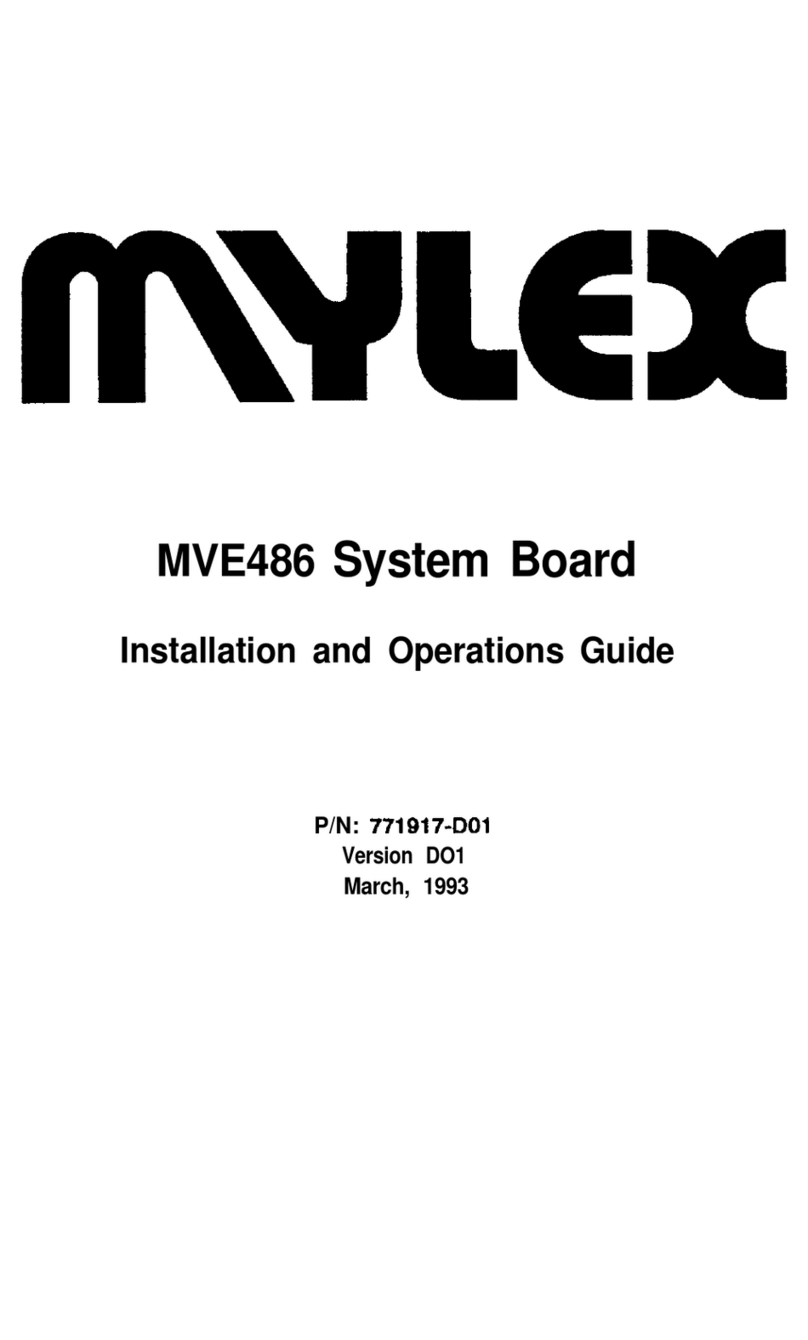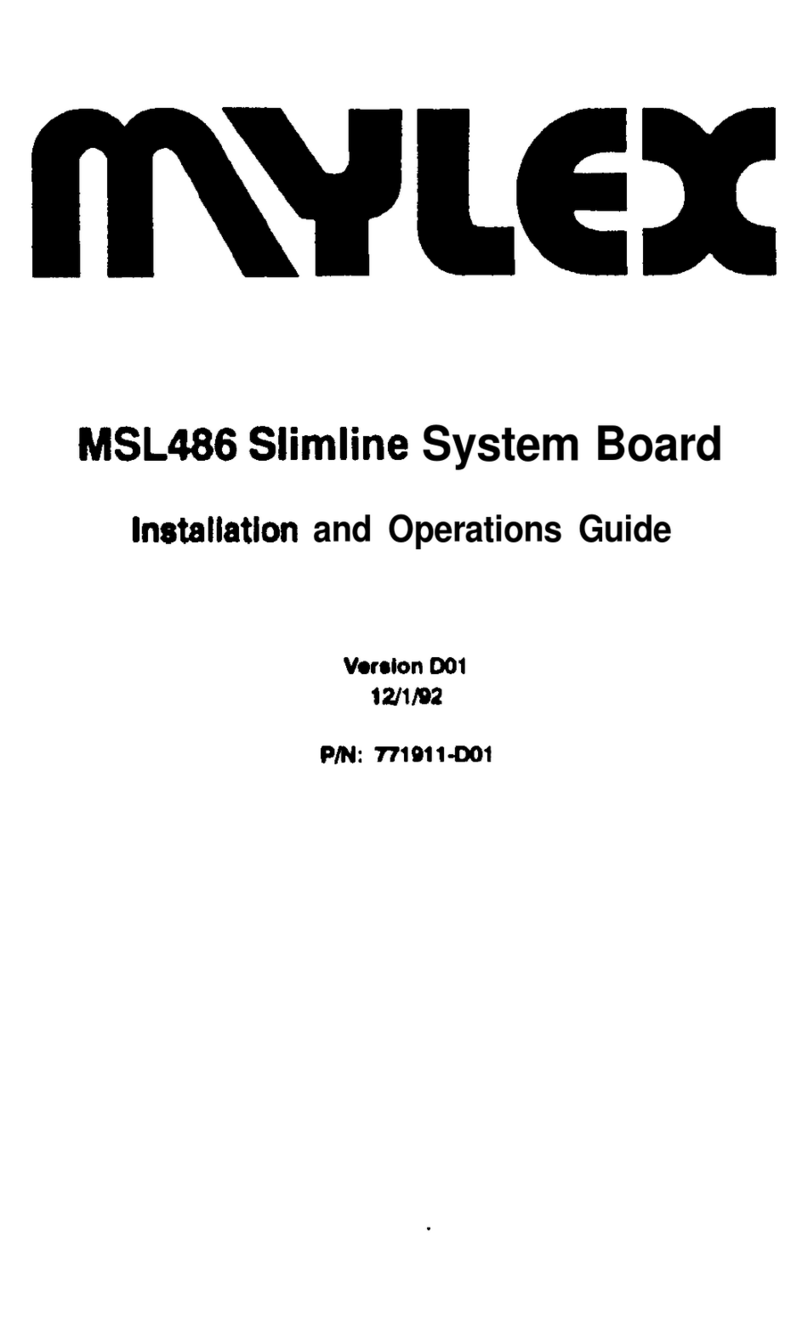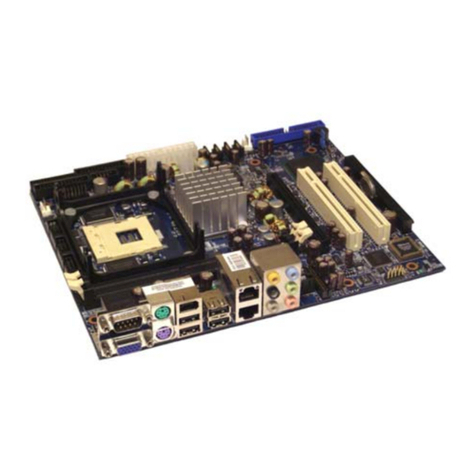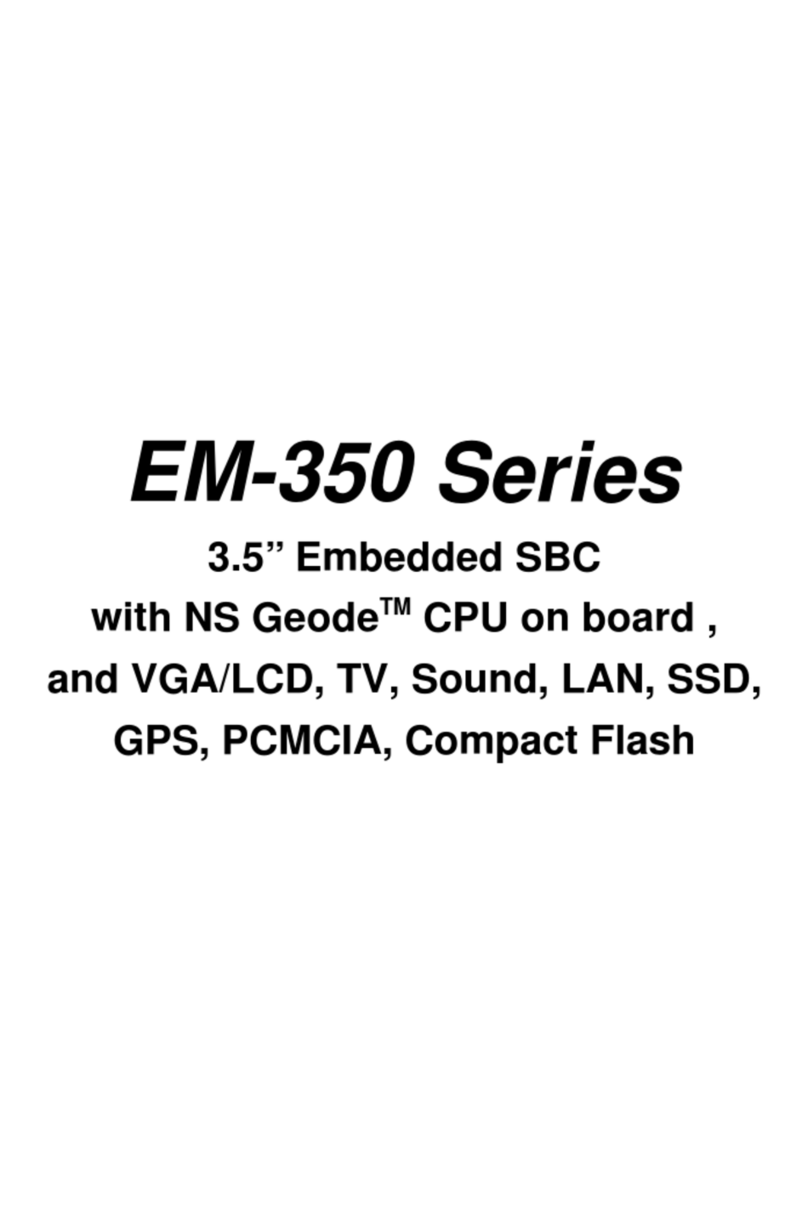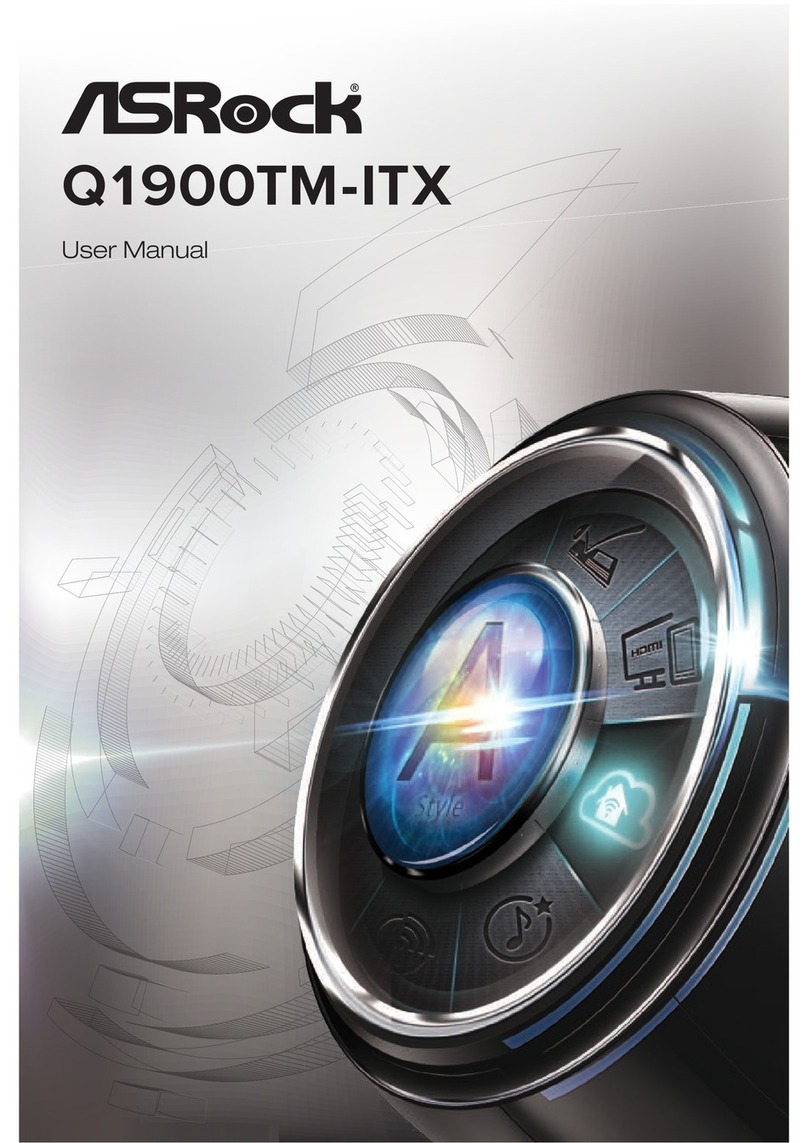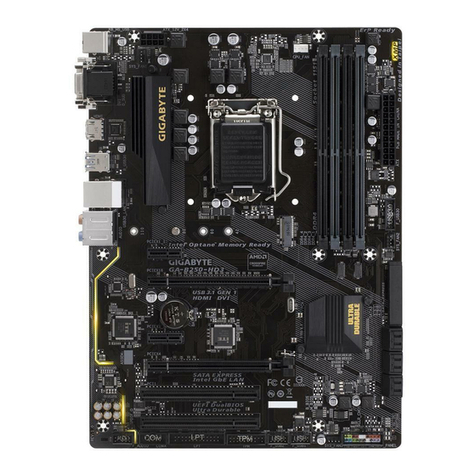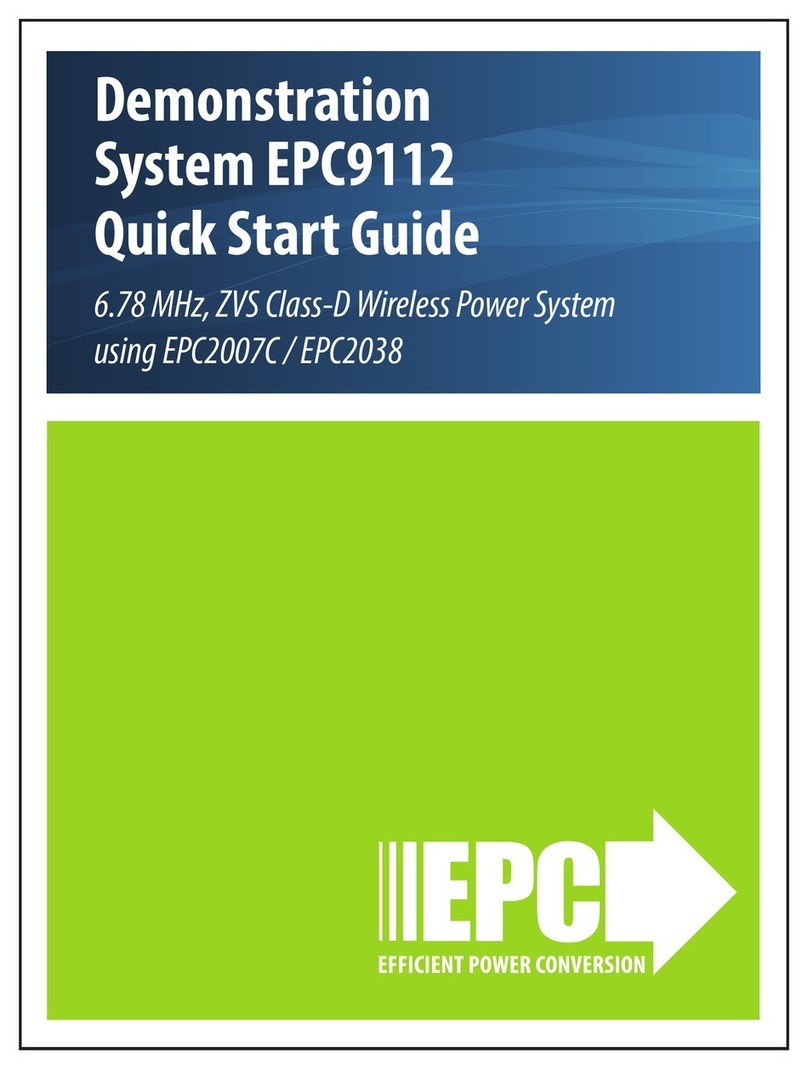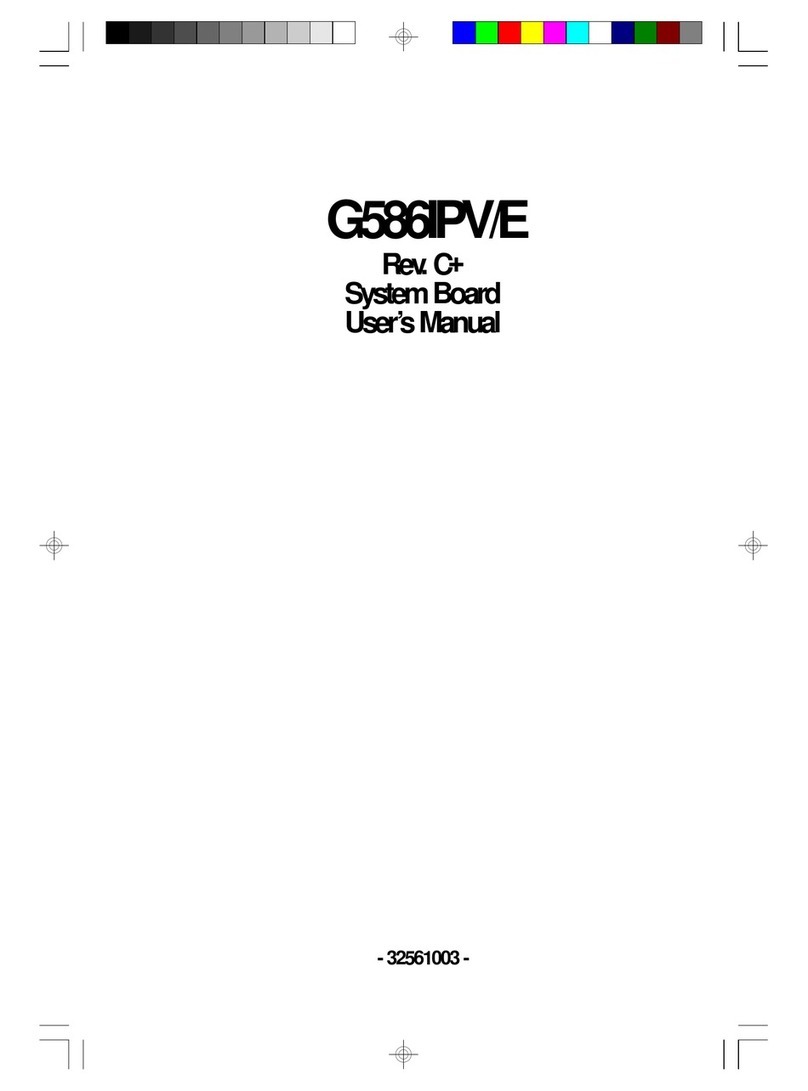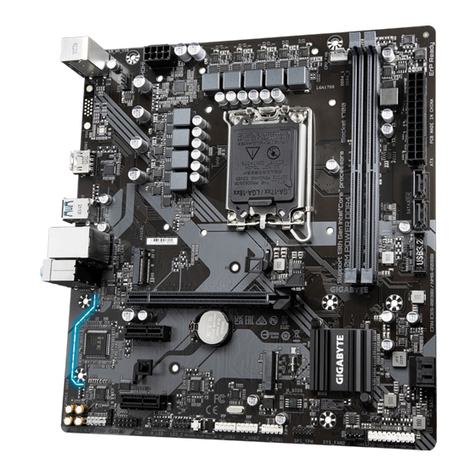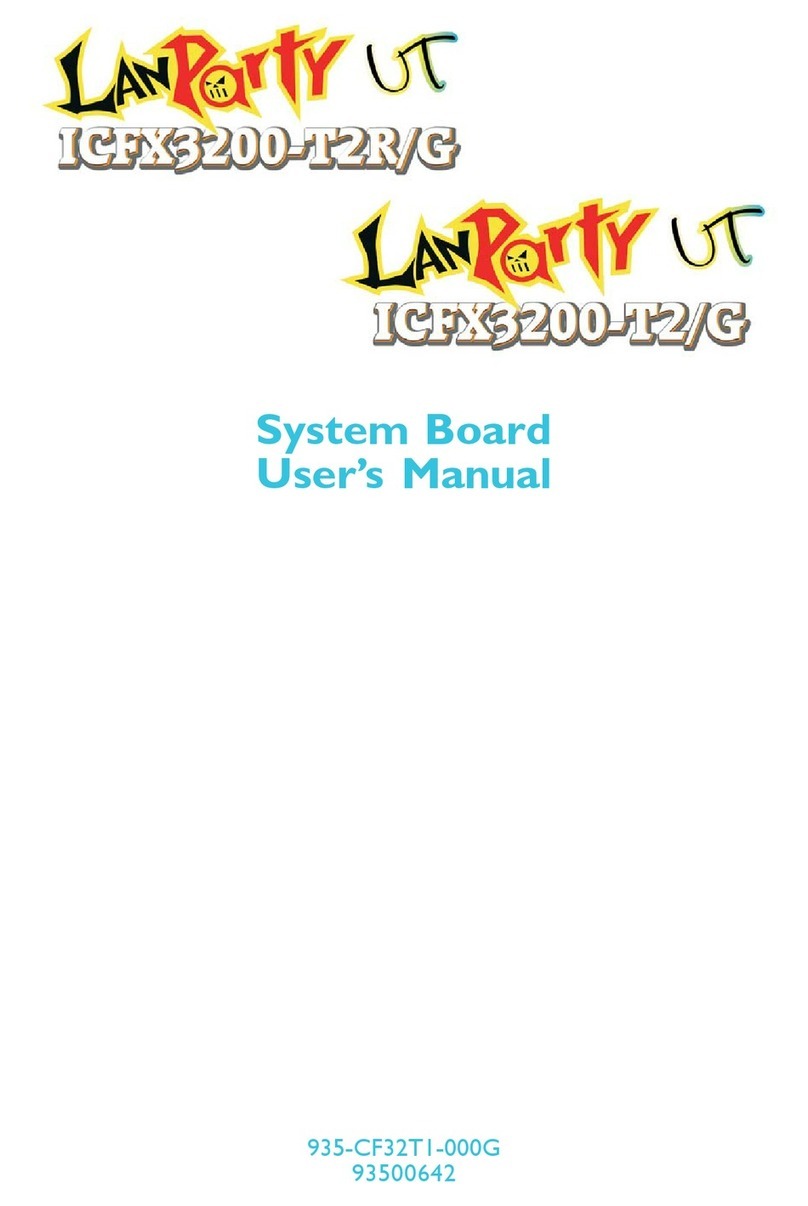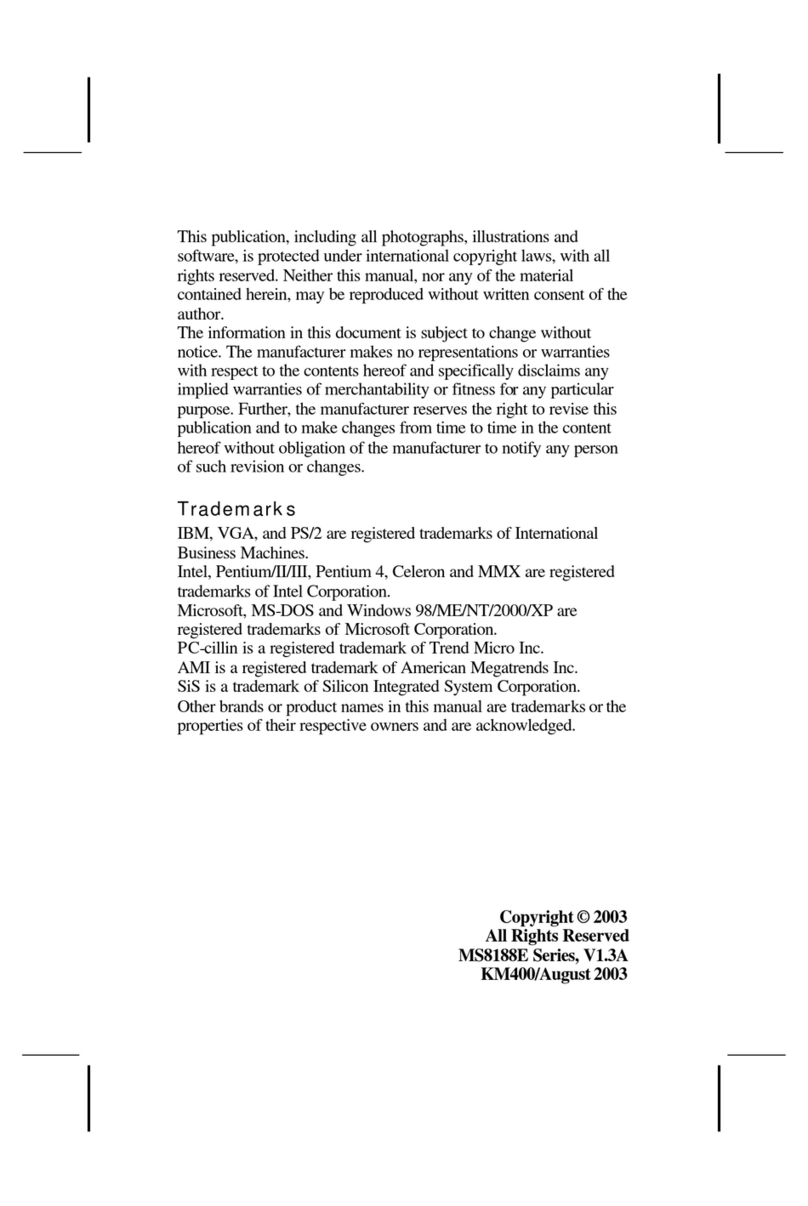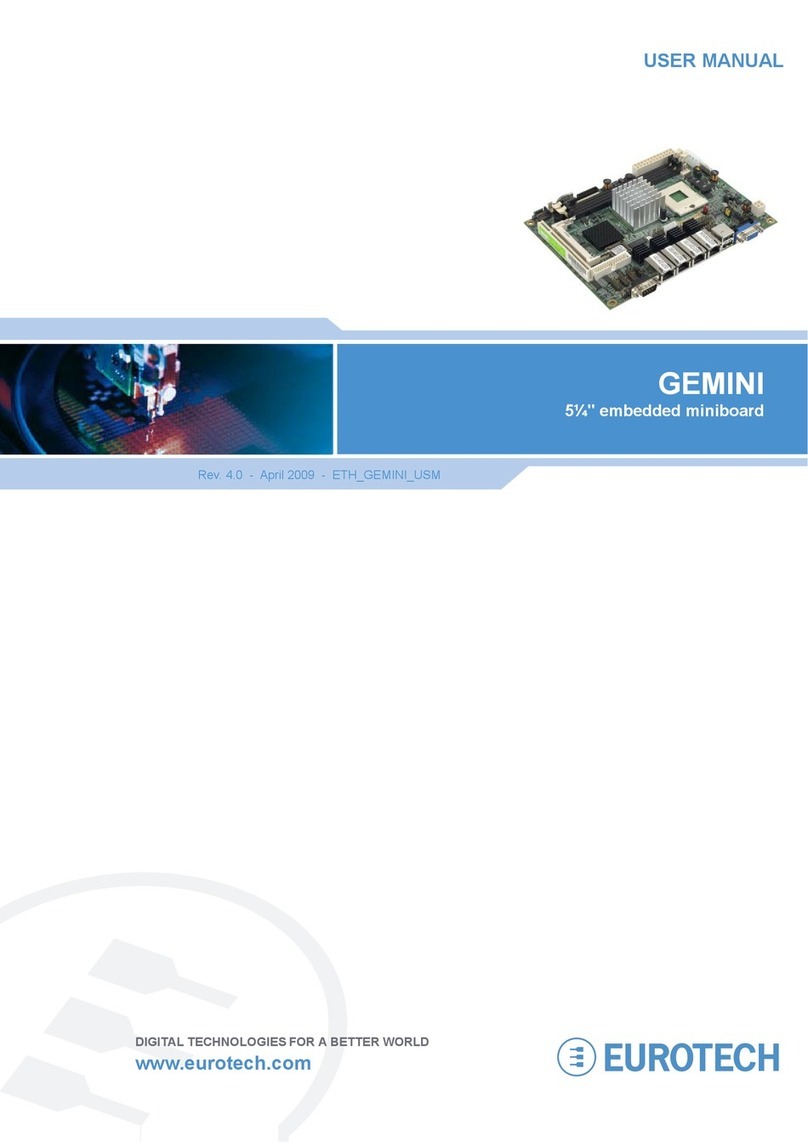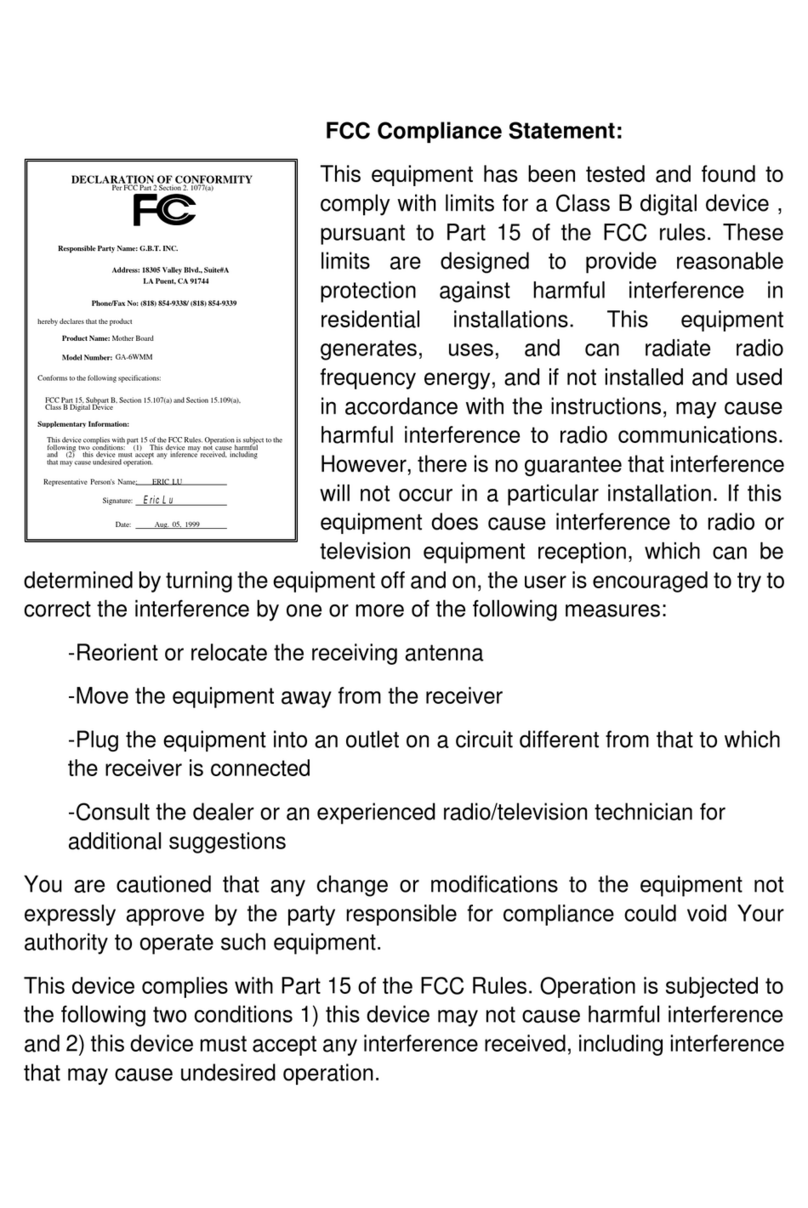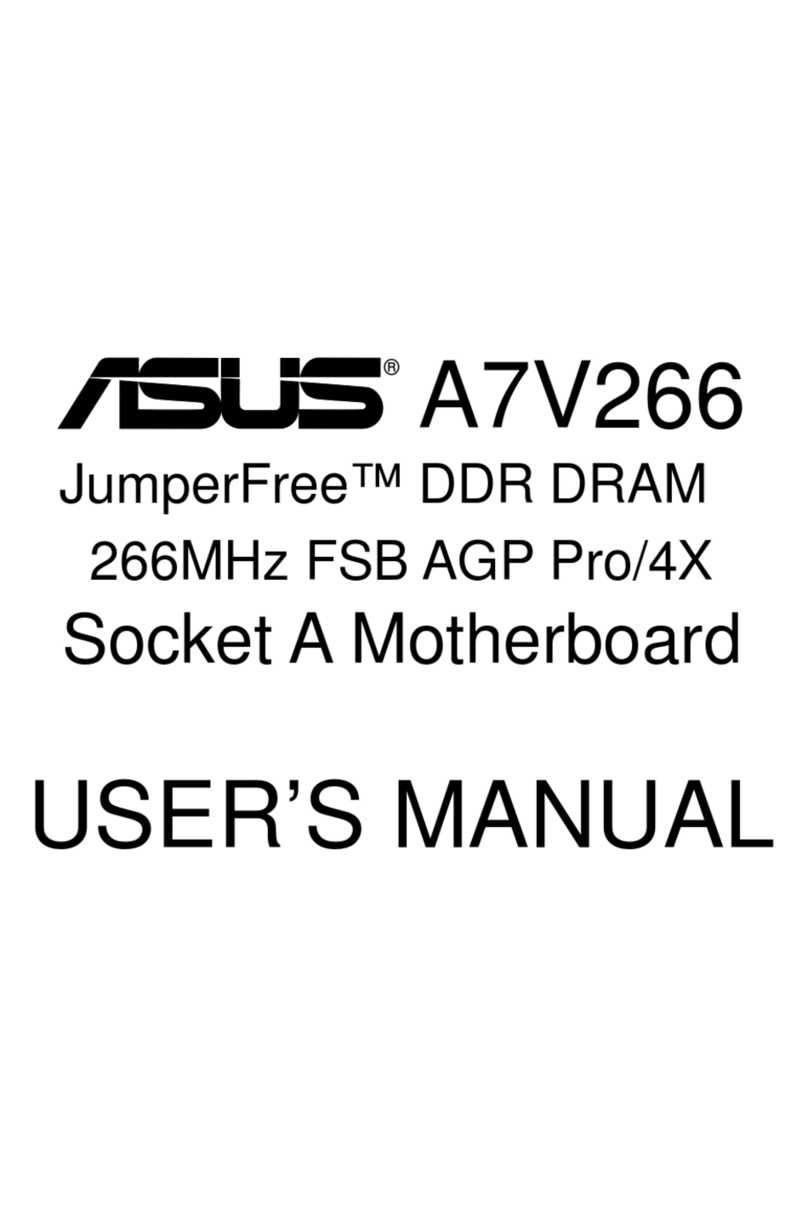Mylex MPE-PNTM User manual

P/N: 771918-D02
Version D02
August, 1994


Copyright 1994 Version D02 i
MPE-PNTM System Board Preface

ii Version D02 Copyright 1994
Preface MPE-PNTM System Board

Table of Contents
Chapter 1: Introduction
Package Contents .....................................1--1
Handling Precautions ...................................1--2
If Troubles Are Encountered ..............................1--2
Overview ............................................1--3
Contents ............................................1--5
What You Will Need....................................1--6
Chapter 2: Installation
A Quick Look At Connectors and Jumper ....................2--1
Installation ...........................................2--4
Planning the System....................................2--5
Installing Memory......................................2--5
Installing SIMM Memory .................................2--6
Installing or Upgrading the CPU ...........................2--6
Color or Mono Video Selection ............................2--8
Chassis Installation.....................................2--9
Connecting Cables ....................................2--10
SCSI Interface .......................................2--10
Finishing Hardware Installation ...........................2--11
Expansion Slots ......................................2--12
Chapter 3: Upgrading
Upgrading the Cache ...................................3--1
Installing the Cache Memory..............................3--2
Installation Steps ...................................3--2
Add--on Cards ........................................3--4
EISA Slots ........................................3--4
PCI Slots .........................................3--4
Copyright 1994 Version D02 vii
Table of Contents MPE-PNTM System Board

Chapter 4: Troubleshooting
Problems and Solutions .................................4--1
Chapter 5: Technical Reference
Specifications.........................................5--1
Appendix A: System Planning Worksheet
Planning Worksheet....................................A--1
Appendix B: Upgrading the MPE--PNTM
Cache Memory .......................................B--1
viii Version D02 Copyright 1994
MPE-PNTM System Board Table of Contents

Introduction
Thank you for making the decision to pur-
chase the Mylex MPE--PNTM. With proper
installation and maintenance, the MPE--
PNTM will provide years of trouble--free op-
eration.
Package Contents
•MPE--PNTM System Board
•Cable Kit (2 serial cables and 1 parallel cable)
•EISA Configuration Utility diskettes
•Driver diskettes for DOS, NetWare, OS/2, NT and
SCO UNIX
•MPE--PNTM BIOS User's Manual
•MPE--PNTM SCSI Software Manual
•EISA Configuration Utility User's Guide
•This manual
•Any pertinent release notes available at the time of
shipment
•System Problem Report form
•Warranty card
Copyright 1994 Version D02 1 - 1
Introduction MPE-PNTM System Board
Introduction

Handling Precautions
The MPE--PNTM contains electronic components
that are highly sensitive to electrostatic discharge.
Use extra caution when handling the MPE--PNTM to
ensure there is adequate grounding around the work
area the board is being installed. ALWAYS wear a
ground strap or ground your body by touching a
grounded object such as an unpainted--painted metal
device connected to power ground.
The MPE--PNTM has delicate crystal oscillators that
can break if subjected to sudden shock such as being
tossed on a table. Use care when moving the MPE--
PNTM from point to point.
If Troubles Are Encountered
If, during the course of installation or operation of the
MPE--PNTM, the board displays improper operation,
first consult this manual's Troubleshooting section,
paying particular attention to the jumper settings, as
well as the BIOS CMOS options. Then contact your
dealer or distributor for additional information. Deal-
ers and Distributors may contact Mylex Technical
Support Department at (510) 796--6100. Be sure to
have the enclosed System Problem Report com-
pletely filled out.
1 - 2 Version D02 Copyright 1994
MPE-PNTM System Board Introduction

Overview
General Description: The MPE--PNTM is a
full sized AT form factor PCI--EISA system
board based on the Intel Pentium microproc-
essor. ThehighlyintegratedASICdesign pro-
vides high performance coupled with a list of
features including: three PCI master slots,
seven bus master EISA slots, Pentium proc-
essor, optional 256K/512K of secondary
write--back cache, up to 192MB of DRAM, in-
tegrated I/O for serial, parallel, IDE and high--
speed floppy drive control and FLASH PROM
BIOS.
EISA BUS Architecture:
EISA has emerged
as the defacto standard for a 32--bit PC BUS.
Backward compatible with the original AT
BUS, as well as providing the highest per-
formance available from a PC standard bus --
33 MB/sec -- , EISA is the architecture of
choice. All slots on the MPE--PNTM are “Bus
Master” and “Burst Mode” compatible ensur-
ing EISA adapter compatibility.
PCI Bus Architecture:
PCI is an emerging
de--facto standard local bus for high--end PC
systems. PCI supports data burst transfer
rates of 132MB/sec. at 33MHz. High speed
peripherals and graphics cards can use the
PCI bus to transfer data at high speed. The
MPE--PNTM supports 3 PCI expansion slots.
Theboardalso hasabuilt--inSCSI--IIcontrol-
ler residing on the PCI bus.
192MB of DRAM Memory:
While most sys-
tem boards only support 32 or 64MB, the
MPE--PNTM quadruples that memory capac-
ityup to 192MB. Thisisamustfor network file
servers and multi--user, time--sharing sys-
tems. The MPE--PNTM supports the new 72
pin standard single as well as double sided
modules of 256Kx36, 512Kx36, 1Mx36,
2Mx36, 4Mx36, 8Mx36.
Copyright 1994 Version D02 1 - 3
Introduction MPE-PNTM System Board
Introduction

256K--512K of Write--Back Cache Memory (Sec-
ondary Cache):
Cache memory is an essential part
of maintaining high system performance. In most
cases, the larger the cache memory, the greater the
system performance. Repetitive programs such as
spread--sheet and CAD applications will benefit the
most. The standard configuration does not include
Cachememory.Toalloweasyupgradeof cache mem-
ory, the SRAM module is used, allowing256K/512K of
cache using standard or burst SRAMs.
Unlike other cache architectures that require the CPU
to write directly to DRAM, the write--back cache is the
most efficient way for cache to write information back
to main memory. This is because the cache can be
written to faster than DRAM. Then the cache circuit
writes the information to the DRAM by itself. The sec-
ondary cache can be set up to operate in write--back
or write--through mode.
Embedded I/O:
The MPE--PNTM includes the latest
generation of Super I/O controllers which provides 2
serial ports, a parallel port, IDE disk interface and
floppy disk controller. The floppy disk controller is ca-
pable of supporting the new “4MB” floppy disk drives.
Just as important, the floppy controller is capable of
data rates of 1MB/sec--—this is a significant benefit in
performance on various floppy tape drives compatible
with the 1MB/sec transfer rates. In addition, the serial
portUARTSare compatiblewith theNational™ 16550
with 16--byte FIFO.
FLASH ROM BIOS:
At one time or another, the need
can arise to update the system BIOS. Usually this
means that the system must be partially disassem-
bled, the old ROM chip removed, discarded, the new
ROM chip installed and the system reassembled.
WithFLASH technology, BIOSupdates aremadesim-
ply by running a program. With the MPE--PNTM there
are no chassis to open, no jumpers to set. Simply run
a DOS program that reads a BIOS binary image file
and then programs the new BIOS into the FLASH
memory chip.
1 - 4 Version D02 Copyright 1994
MPE-PNTM System Board Introduction

SCSI Interface:
The MPE--PNTM features
an on--board Fast and Wide SCSI Interface.
The SCSI Interface is connected to the PCI
bus on the motherboard, for the highest data
throughput.
Contents: This systemboard manual is broken down
into five chapters, including this one, and
two appendixes. Discussed in this manual
are:
Installation (Chapter 2) — This describes
the major steps for installing the MPE--PNTM
into a chassis and making all necessary
hardware connections including I/O cables.
Troubleshooting (Chapter 3) — This
section provides hints on resolving technical
problems with the MPE--PNTM system
board.
Upgrading (Chapter 4) — This section
describes the steps necessary toupgradethe
CPU and cache on the MPE--PNTM.
Technical Reference (Chapter 5) — This
section covers some of the major aspects of
the MPE--PNTM's design, as well as pin
assignments and compatibility and
benchmark information.
Also in this manual is a system planning
worksheet (Appendix A) and upgrade order
information (Appendix B).
Copyright 1994 Version D02 1 - 5
Introduction MPE-PNTM System Board
Introduction

What You Will Need
Before you begin to install the MPE--PNTM in a
chassis, the following tools will be required: A
Phillips and flat blade screwdriver, plastic stand--
offs(these are normallysuppliedwith thechassis)
and assorted screws.
A good working knowledge of computers is highly
recommended for installing a system board. It is
not advised that a novice attempt installation of
the MPE--PNTM.
1 - 6 Version D02 Copyright 1994
MPE-PNTM System Board Introduction

Chapter 2: Installation
A Quick Look At Connectors and Jumpers
The following is the list of jumpers and the
corresponding use for the MPE--PNTM moth-
erboard. See Figure 2--0 for jumper loca-
tions.
ALL JUMPERS/CONNECTORS LOCATED ON
MPE--PNTM MOTHERBOARD DEFAULT SETTINGS
J1 IDE DMA: OPEN
OPEN--NO DMA ON IDE (DE-
FAULT)
CLOSED--IDE DMA ON CHANNEL
6
J2 RESERVED OPEN
J3 COLOR/MONOCHROME VIDEO
SELECTION CLOSED (COLOR)
J4 FRONT PANEL RESET --—--—
J5 KEYBOARD LOCK (1x5 PIN) --—--—
J6 SPEAKER CONNECTOR (1x4 PIN) --—--—
J7 RESERVED OPEN
J8 RESERVED 2--3 (CLOSED)
J9 IDE CONNECTOR (40 PIN 20x2) --—--—
J10 POWER CONNECTOR --—--—
J11 RESERVED OPEN
Copyright 1994 Version D02 2 - 1
Installation MPE-PNTM System Board

J12 RESERVED OPEN
J13 SERIAL PORT 1 (10 PIN 5x2) --—--—
J14 SERIAL PORT 2 (10 PIN 5x2) --—--—
J15 PARALLEL PRINTER 26 PINS
(13x2 PIN) --—--—
J16 FLOPPY CONNECTOR 34 PIN
(2x17 PIN) --—--—
J17 KEYBOARD CONNECTOR 1x5 PIN --—--—
J18 HEAT SINK FAN POWER (12V) --—--—
J19 PENTIUM CACHE WRITE--BACK/
WRITE--THRU
OPEN -- PENTIUM INTERNAL
CACHE IS WRITE--BACK (DE-
FAULT)
CLOSED -- PENTIUM INTERNAL
CACHE IS WRITE--THRU
OPEN
J20 SCSI CONNECTOR 50 PIN (2x25) --—--—
J21 KEYBOARD CONNECTOR (DB--5
SHIELDED) --—--—
J22 HARD DISK ACTIVITY LED. PIN 2
IS POSITIVE. --—--—
J23 TERMINATOR POWER FOR SCSI
INTERFACE CLOSED
-- MOTHERBOARD SUPPLIES
TERMINATION POWER FOR SCSI
BUS (DEFAULT)
OPEN -- TERMINATION POWER
NOT GIVEN BY MOTHERBOARD
CLOSED
2 - 2 Version D02 Copyright 1994
MPE-PNTM System Board Installation

J24 SCSI TERMINATION
CLOSED -- ENABLE MOTHER-
BOARD TERMINATION FOR SCSI
BUS (DEFAULT) OPEN -- DIS-
ABLE MOTHERBOARD TERMINA-
TION FOR SCSI
CLOSED
J26 RESERVED OPEN
J29 RESERVED OPEN
J30 EXTERNAL CACHE PARITY SUP-
PORT
1--2, 3--4 CLOSED -- NO PARITY
ON EXTERNAL CACHE (DEFAULT)
1--3, 2--4 CLOSED -- EXTERNAL
CACHE SUPPORTS PARITY
CLOSE 1--2 & 3--4
J25 CACHE CONFIGURATION SEE INSTALLING
CACHE MEMORY SEC-
TION
J27 CACHE CONFIGURATION SEE INSTALLING
CACHE MEMORY SEC-
TION
J28 CACHE TYPE
(1--2) CLOSED -- STANDARD
SRAM CACHE (DEFAULT)
(2--3) CLOSED -- BURST SRAM
CACHE
CLOSED
Installation
Complete the following steps for installing the
MPE--PNTM system board into a chassis.
Copyright 1994 Version D02 2 - 3
Installation MPE-PNTM System Board

Installation
1. Planning the system configuration.
2. Installing SIMM memory.
3. Changing any of the hardware jumpers, if the
system configuration requires them to be
changed.
4. Installing the board into the chassis.
5. Powering--up the system and setting the
CMOS configuration information.
2 - 4 Version D02 Copyright 1994
MPE-PNTM System Board Installation
Figure 2-1. MPE-PNTM System Board

Planning the System
Using the simple form located in Appendix A,
the resources available can be planned and
any problems such as hardware conflicts can
be avoided ahead of time.It would be a good
idea to complete this form before system as-
sembly is performed.
Installing Memory
The MPE--PNTM provides six 72--pin SIMM
sockets capable of taking single as well as
double--sided SIMMs. The MPE--PNTM sup-
ports different SIMM sizes. All SIMMs should
be 60 or 70 ns SIMMs.
The six SIMM sockets can be viewed as three
BANKS of DRAM.
BANK0 is made up of U44 and U38. BANK1
is made up of U37 and U36 and BANK2 is
made up of U33 and U32.
Two SIMM DRAM modules form one BANK.
SIMM modules within a BANK must be of the
same type. The minimum number of SIMM
modules required is two and must be in
BANK0. At any moment, one must have two,
four, or six SIMM modules. Onecould use dif-
ferenttype ofSIMM modulesacross BANKS.
The minimum memory required is 2MB, and
themaximumsupported is 192MB. 256Kx36,
512Kx36, 1MBx36, 2MBx36, 4MBx36 and
8MBx36 SIMM DRAM modules are sup-
ported. BANK0 must be populated. Addi-
tional memory can be added by first populat-
ing BANK1 and then BANK2.
Copyright 1994 Version D02 2 - 5
Installation MPE-PNTM System Board

BANK SIMM MODULES
BANK0 U44, U38
BANK1 U37, U36
BANK2 U33, U32
Installing the SIMM Memory
While installing the SIMM (cache or main memory),
the Pin 1 edge of the SIMM should be towards the Pin
1side of theSIMMsocketonthe motherboard. Cache
SIMM module socket (U60) is located on the edge of
the board near the crystal oscillator.
SIZE BANK 0 BANK 1 BANK 2
2MB 1MB X 2 NONE NONE
4MB 1MB X 2 1MB X 2 NONE
4MB 2MB X 2 NONE NONE
6MB 1MB X 2 1MB X 2 1MB X 2
8MB 2MB X 2 2MB X 2 NONE
8MB 4MB X 2 NONE NONE
12MB 2MB X 2 2MB X 2 2MB X 2
12MB 4MB X 2 2MB X 2 NONE
16MB 4MB X 2 2MB X 2 2MB X 2
16MB 4MB X 2 4MB X 2 NONE
16MB 8MB X 2 NONE NONE
20MB 4MB X 2 4MB X 2 2MB X 2
20MB 8MB X 2 2MB X 2 NONE
24MB 4MB X 2 4MB X 2 4MB X 2
24MB 8MB X 2 2MB X 2 2MB X 2
24MB 8MB X 2 4MB X 2 NONE
32MB 16MB X 2 NONE NONE
2 - 6 Version D02 Copyright 1994
MPE-PNTM System Board Installation

SIZE BANK 0 BANK 1 BANK 2
32MB 8MB X 2 8 MB X 2 NONE
32MB 8MB X 2 4MB X 2 4MB X 2
48MB 16MB X 2 8MB X 2 NONE
48MB 16MB X 2 4MB X 2 4MB X 2
48MB 8MB X 2 8MB X 2 8MB X 2
64MB 32MB X 2 NONE NONE
64KB 16MB X 2 16MB X 2 NONE
64MB 16MB X 2 8MB X 2 8MB X 2
96MB 32MB X 2 16MB X 2 NONE
96MB 32MB X 2 8MB X 2 8MB X 2
96MB 16MB X 2 16MB X 2 16MB X 2
128MB 32MB X 2 32MB X 2 NONE
128MB 32MB X 2 16MB X 2 16MB X 2
192MB 32MB X 2 32MB X 2 32MB X 2
1MB=256KB X 36 8MB=2MB X 36
2MB=512KB X 36 16MB=4MB X 36
4MB=1MB X 36 32MB=8MB X 36
Installing or Upgrading the CPU
The MPE--PNTM is equipped with a special IF socket
(Zero Insertion Force) to install or upgrade:
PENTIUM 60MHz
PENTIUM 66MHz
Once the processor that will be installed has been ob-
tained, follow these simple steps.
Copyright 1994 Version D02 2 - 7
Installation MPE-PNTM System Board

1. Locate the pin 1 indicator on the PENTIUM processor
chip. This is usually indicated by a small black dot or a
diagonal notch on one corner of the chip.
2. Place the chip into position so that the pin one indicator is
properly aligned with socket.
3. Once the pin 1 orientation is confirmed, gently press
down the Pentium processor chip so that it sits flat on the
ZIF socket.
4. The crystal oscillator Y2 (near the cache module) should
be 60MHz/66MHz depending on the Pentium speed.
However, the 60MHz crystal can be used for the Pentium
60/66MHz chip.
Color or Mono Video Selection
Jumper J3 is used set the type of video adapter. The jumper placed
over the two pins (closed), indicates a color video adapter is in-
stalled. The jumper removed (open), indicates a monochrome
adapter is installed. If both a color and mono adapter are installed,
place the jumper in the position to indicate which video adapter will
be the primary video adapter.
2 - 8 Version D02 Copyright 1994
MPE-PNTM System Board Installation
Table of contents
Other Mylex Motherboard manuals



